Tuesday, November 24. 2009
A Paris, Delanoë pousse la vidéosurveillance
L'extension sur le territoire parisien du plan de caméras de la préfecture a été voté lundi soir par le PS, l'UMP et le Nouveau Centre. Contre les Verts et le PC.
L'extension du plan de vidéosurveillance de la préfecture de police à Paris a été votée lundi soir au conseil de Paris au terme d'un débat long et animé qui s'est conclu par un scrutin électronique.
Après trois heures de séance, la délibération de la mairie autorisant cette extension sur le territoire parisien a été votée par 112 voix pour (PS, UMP et Centre et indépendants) et 16 voix contre (les Verts et le PCF) ainsi que 4 abstentions.
L'exécutif, malgré les protestations du président des Verts, Sylvain Garel, a fait voter un amendement de fusion des 1000 amendements déposés par les Verts, afin d'empêcher que le débat ne s'éternise après que chacun eut exposé son point de vue.
Les Verts, partie prenante de la majorité de gauche au conseil de Paris, considèrent ce texte comme "un piège que la droite tend à la majorité parisienne" et se sont opposés à ce projet "voulu par Hortefeux et Sarkozy".
Le maire PS, Bertrand Delanoë, avait souhaité un débat "serein et honnête", estimant que "l'insécurité est à bien des égards une injustice sociale".
Le préfet de police, Michel Gaudin, a souligné que l'Etat allait "consentir en faveur des Parisiens le plus gros investissement français en matière de vidéoprotection", l'Etat finançant environ 95% de l'investissement et la quasi totalité du fonctionnement.
M. Gaudin a cité une étude de l'inspection générale de l'administration (sur 9 ans de statistiques) selon laquelle "dans les communes qui s'en sont dotées, la délinquance diminue presque deux fois plus vite que dans celles qui n'en ont pas". Un rapport dont les conclusions sont critiquées par les opposants à la vidéosurveillance.
L'investissement est évalué "entre 80 et 100 M EUR" pour un partenariat public-privé, soit sur 15 ans une évaluation à "200-250 MEUR" (investissement et fonctionnement), selon M. Gaudin.
La Ville participera modestement à hauteur de 5 M EUR (subvention d'investissement) à ce plan, alors que le budget annuel municipal des actions de prévention à Paris est de 200 M EUR.
(source AFP)
-----
Via Libération
Personal comment:
On peut une fois encore se poser la question de savoir ce qu'il advient de l'espace public "surveillé", lorsque celui-ci est surveillé par un partenariat "public-privé" ou même dans certain cas par des entreprises privées auxquelles l'Etat passe commande... Cette portion d'espace surveillée n'est de tout évidence plus un espace public au sens où on pouvait l'entendre jusqu'ici, ce n'est pas non plus un espace privé. Alors, qu'est-ce?
Monday, May 25. 2009
The Cybernetic Pioneer of Video Art: Nam June Paik
By Carolyn Kane on Wednesday, May 6th, 2009 at 12:30 pm.
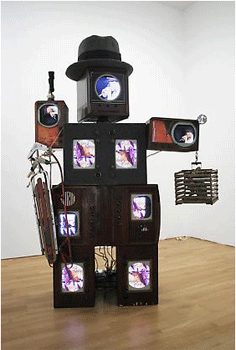
If we look back forty years, video’s ability to continuously process new data in real time and render it for visual display make it an important correlate technology for contemporary computing systems. In 1965, SONY placed the first black and white portapak video camera on the commercial market. The new technology granted easy portability, immediacy, low monetary investment, and for the first time, made video available to artists.1 Video historian John Hanhardt has noted that, at the time, the excitement surrounding the new medium was most keenly reflected in the early experimental works of Nam June Paik (1932-2006). This era in Paik’s career is also marked by his emerging interest in cybernetics.
Cybernetics emerged in the 1940s from MIT mathematician Norbert Wiener. Instead of viewing communication as a one-way ticket between cause and effect, Wiener looked at communication as a circular system of information exchange. His most well known example is a ship’s steering system, an example that echoes the Greek origin of the term, kybernetikos, meaning to steer or guide.2 While cybernetics eventually opened the doors to artificial intelligence projects such as smart bombs, smart planes, robots, and various other military “defense” technologies, Wiener has nonetheless maintained a sharp critical and ethical eye on the applications of the automated systems he doctored.
Wiener was not alone. In the 1960s and 1970s, Nam June Paik, and many of his pioneering video artist colleagues and Fluxus collaborators took the visionary work of Wiener, the electric prophesies of McLuhan and Gregory Bateson and the utopic designs of Buckminster Fuller and concurred that the new video medium would usher in a social utopia that would extend far beyond the spheres of the 1970s experimental art world. For these early media artists, the feedback loops, live circuits, and video flows, coupled with the electronic image’s immediate and physiological stimulations, when used in distinction to commercial models, posited potent possibilities for cybernetic consciousness, ecological human-machine systems, and an end to top-down power relations. In short, the rise of an egalitarian, democratic society through electronic media. In order to fully appreciate Paik’s work, we must remember this historical context. A solo show is now on view at the James Cohan Gallery in Chelsea, "Nam June Paik: Live Feed: 1972 -1994." The show features several of Paik’s older and more recent video installations, all of which reflect his cybernetic ambitions for video technology.
The first few pieces in the exhibition are animal-man-machine hybrids, a style Paik has been developing since the 1980s, with works such as the Family Robot series (1986). These robot pieces reflect Paik’s life-long interest in cyborgs (hybrids of man and machine), offshoots of cybernetic research. In 1996 Paik wrote, “Cybernetics is the exploration of boundary regions between and across various existing sciences.”3 Its fusions went beyond human beings to include animals, objects, and ecological fusions with machines such as Watchdog II (1997) –– a pun on an actual dog and the “media as watchdog” and Attila the Hun (1993).
Also in the show are Beuys Voice (1990) and Gertrude Stein (1990), two celebrity robots. These cyborgs both personify and mechanize the actual historical figures: Joseph Beuys, the conceptual artist, and Gertrude Stein, the modern writer. Stein wears a polyester translucent skirt draped around her waist. She has miniature television monitors for a belly, kneecaps, and shins, all of which emit an ongoing and colorful electronic glow. For breasts, two old records are installed onto the surface of her robot skin. Old victrola-horns are used for arms.
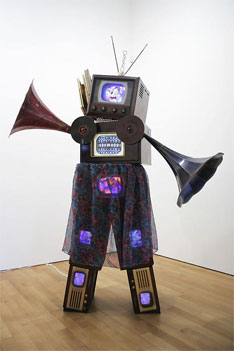
Where the Stein robot references Gertrude Stein’s actual work and writing (Stein wrote prose that emphasized sonic dimensions—for instance take the rhythmical sound of her well-known sentence “A rose is a rose is a rose”), the Joseph Beuys robot alludes to Beuys’ art works and persona. Beuys holds a bird in a cage––likely a reference to fellow Fluxus and conceptual artists Joe Jones, who made a self-playing violin in a birdcage. The felt hat resting on top of the robot head no doubt refers to the felt grey hat that Beuys is known for always having worn. The celebrity robots pay great respect to these immortal figures. As Donna Haraway declared in The Cyborg Manifesto, “I’d rather be a cyborg than a goddess.”4 One could only assume Paik would agree.
The mixture of old and new has always been at play in Paik’s work. In Stein, old media such as records, victrola-horns, and vintage television set casings form the structure of the robot-body. But inside these old and bulky boxes, newer and smaller monitors reside. It may appear that the newer television sets have been used to update the older ones; to preserve the installation for ease of display, but this is not the case. Paik has been housing newer monitors inside vintage casings from the start. This is confirmed by gallery owner James Cohan, whom I was fortunate enough to run into while visiting the gallery last week. The bulky-old boxes tell a story about the history of electronic and acoustic media––that the gradual miniaturization, democratization, and streamlining is something that we can only recognize retroactively.
Cybernetics is not just about human/animal-machine hybrids, but also about environments, ecologies and consciousness. TV Bed (1971 / 92), and Enlightenment Compressed (1994) are newer pieces that harp back to, and update, Paik’s earlier works. TV Bed, according to the gallery, is an ode to Paik’s muse’s Charlotte Moorman. Moorman collaborated on several pieces with Paik, including TV Bra (1975). Images of this wacky 1975 performance appear on the leg-monitors of the Gertrude Stein robot.
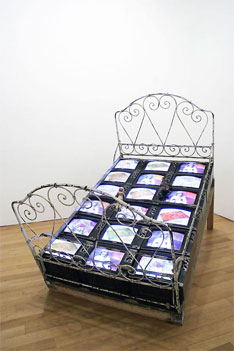
Paik is well known for transforming the architectural function of the television set from a mere box to an element distributed in space. However, these interventions must also be contextualized with his ongoing interest in cybernetics, a theory of animals and machines in their environment. In 1971 Paik asserted that today, the “nature of [the] environment is much more on TV than on film or painting. In fact, TV (its random movement of tiny electrons) is the environment.”5 TV Fish (2004) and Videochandelier X (1991), also in the Cohan exhibition, reflect this attitude. TV Fish involves a large fish tank filled with real goldfish. The goldfish swim about the tank as a television monitor flashes behind them. One gets the sense the goldfish move to the beat of the monitor’s syncopations. Videochandelier X decoratively distributes mini television monitors in an ornamental light fixture hung from the ceiling. Both tungsten light and TV light shine down on you from above. These pieces estrange the naturalized position of the television in the living room, or stand. Vision and viewing practices are stretched so that one sees an object in space, abstract colors, and patterns, before, and perhaps regardless of, the television’s content or cognitive meaning.
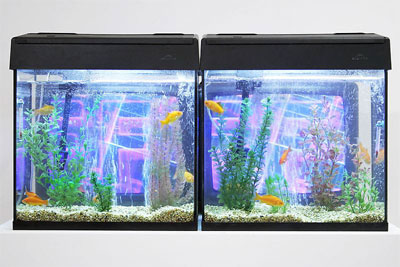
Further exploration of the new systems-thinking comes through in Enlightenment Compressed, a miniaturized version of the celebrated TV Buddha (1974) that is, in my view, the highlight of the Cohan exhibit. In both pieces, a live camera is placed on the front of the mini television monitor. The camera receives a feed of the image of the bronze Buddha statue in front of it. The circuit then feeds this image signal back into the television monitor, resulting in the Buddha’s image appearing on the screen in front of him. In video terminology, this is known as a “closed feedback loop,” meaning that the video signal and the image it generates are united in one circuit. In 1974 Paik reminded us that “two way television came before one-way television—from radar.”6 The Buddha installations show us what television could be––beyond the limitations of the one-way, top-down, industrial broadcast model.
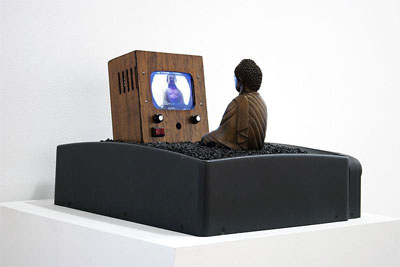
Enlightenment Compressed and TV Buddha function more as systems and networks that criticize the one-way flow of commercial broadcasting, and yet also offer alternative possibilities for television viewing, possibilities that have always existed with the technology, but have been suppressed by industry mandates. Canadian media scholar Marshall McLuhan provocatively argued in the 1960s that television sets are extensions of the human nervous system. When we are watching we are “plugged in”––creating a feedback loop that extends the body into the machinery, and the machine back into the body. McLuhan also drew on the myth of Narcissus to describe the televisual experience. Like Narcissus, one is so intoxicated and absorbed by the electronic image, he / she fails to recognize it is actually an image of oneself that is reflected back to them.7 Enlightenment Compressed and TV Buddha suggest that this mode of televisual experience is analogous to the practices of Zen meditation. For Paik, television provided an enlightening experience where one transcended the self––not in a mystical or religious way, but though the material technical system that was grounded in the real world. World as concept, mind as space.
Paik has since shown his work internationally in solo exhibitions worldwide. Venues include the Museum of Modern Art, New York (1977); The Whitney Museum of American Art (1982), Centre Georges Pompidou (1982); The San Francisco Museum of Modern Art (1989); The National Museum of Contemporary Art, Seoul (1992); and The Solomon R. Guggenheim Museum (2000). 8 He recently passed away in 2006, at the age of seventy-five. If you have not yet seen Paik’s work in person, the James Cohan Gallery is ideal for initiation. For those already familiar with his work, the exhibition is an opportunity to revisit important pieces from the artist’s long career. The show is open at the James Cohan Gallery, 533 West 26th Street, NY, through May 30, 2009.
1. Paik in Global Groove 2004, eds. Nam June Paik, Jon Ippolito and John G. Hanhardt. New York: Guggenheim Museum, 111.
2. Norbert Wiener. Cybernetics, 1947.
3. Paik in Global Groove 2004, 107.
4. Haraway, “A Cyborg Manifesto” in Simians, Cyborgs and Women: The Reinvention of Nature, 1991.
5. Paik in Global Groove 2004, 107.
6. A Conversation. 1974., eds. Joseph Beuys, Douglas Davis, Nam June Paik, Bill Viola, Ronald Feldman Fine Arts and Electronic Arts Intermix.
7. McLuhan, Understanding Media.
8. James Cohan Gallery. Nam June Paik: Live Feed: 1972 -1994. 2009 [cited April 23 2009]. Available from the press release.
References
A Conversation: Joseph Beuys, Douglas Davis, and Nam June Paik [Videorecording]. Anonymous New York, New York: Electronic Arts Intermix, 1974.
Surveying the First Decade [Videorecording]. Directed by Art Institute of Chicago. Video Data Bank, Electronic Arts Intermix and Bay Area Video Coalition. Chicago, Illinois: Video Data Bank, 1995.
Donna Haraway, “A Cyborg Manifesto: Science, Technology, and Socialist-Feminism in the Late Twentieth Century,” in Simians, Cyborgs and Women: The Reinvention of Nature. New York, New York: Routledge, 1991. pp.149-181.
James Cohan. Personal Communication. New York, New York: James Cohan Gallery. April 20, 2009.
James Cohan Gallery. "Nam June Paik: Live Feed: 1972 -1994." http://www.jamescohan.com/exhibitions/2009-04-14_nam-june-paik/press-release/ (accessed April 23, 2009).
Marshall McLuhan. Understanding Media: The Extensions of Man, edited by W. Terrence Gordon. Corte Madera, California: Gingko Press, 2003.
Nam June Paik 1932-2006. Global Groove 2004, edited by Nam June Paik, Jon Ippolito and John G. Hanhardt. New York, New York: Guggenheim Museum, 2004.
Nam June Paik, Thomas Kellein, and Toni Stoss. Nam June Paik, Video Time - Video Space. Stuttgart: Edition Cantz, 1991.
Norbert Wiener. Cybernetics. New York, New York: J. Wiley, 1948.
Carolyn Kane is Rhizome's Curatorial Fellow.
-----
Via Rhizome
Personal comment:
Utopies artistico-technologicao-sociales au temps de Paik et des débuts de l'art utilisant la vidéo. Rapport intéressant entre théories cybernétiques (influence forte de la deuxième moitié du XXème), mouvement artistique (Fluxus) et architectural (B. Fuller), nouvelles technologies (vidéo) et théories sociales...
Wednesday, December 10. 2008
NFL first 3D HD Live Game aftermath
How could a NFL game like this gathered so much national attention : a dysfunctional organization vs underachiever at the week lowest possible viewers’ broadcast - Thursday night football? Both are the losers’ teams of the rich-n-wealthy state of California? No, it was the league historical moment- first ever NFL game shot and live broadcast in 3rd dimensional, and it was aired in HD too. Now that the game was over and since it was broadcasted in selected theaters, and only a few fortunate invitees got to see it; let’s see what the viewers thought about the full digital 3D sport.
Yahoo Tech reported few technical glitches here and there; couple feeds were blacked out in the first half of the same, viewings pulling the goggle off due to few weird effect with sudden camera movement and refocusing. Overall; the audiences love the 3D visual effects despite a dull match-up.
What about the polarized glasses and did it work? The Boston media described the technology in detail “Once your eyes adjusted to the glasses, which didn’t take long, the visuals were stunning, the picture sharp, and when the graphics came up on the screen, you felt as if you could reach out and pluck them off with your fingers.”
The game has not decided the future of 3D sport, but it certainly sparked a few interested parties. The league, team owners and broadcasting committee will meet and discuss the possibility some time before March. Now, guess where the next 3D HD football live broadcast will be? BCS Championship to be held at Miami and live broadcast at CES show 2009! A few lucky us will be there.
Related Links:
Thursday, October 23. 2008
Home Sweet Office
.jpg)

-
Le retour du télétravail (bureaux plus petits, moins de frais de transports et de location, moins de pollution, etc.), avec des outils performants (parait-il) et moins chers. Mentionné entre autre dans l'article de Wired magazine les produits de LifeSize (LifeSize Express) avec un système de téléconférence "HD" à moins de 5'000$
Article complet ICI.
Related Links:
Thursday, August 07. 2008
A Spherical Camera Sensor
A stretchable circuit allows researchers to make simple, high-quality camera sensors.
By Kate Greene
-
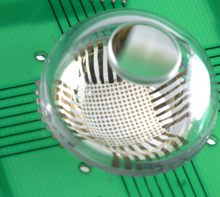 |
| The eyes have it: This camera consists of a hemisphere-shaped array of photodetectors (white square with gold-colored dots) and a single lens atop a transparent globe. The curved shape of the photodetector array provides a wide field of view and high-quality images in a compact package. Credit: Beckman Institute, University of Illinois |
Today's digital cameras are remarkable devices, but even the most advanced cameras lack the simplicity and quality of the human eye. Now, researchers at the University of Illinois at Urbana-Champaign have built a spherical camera that follows the form and function of a human eye by building a circuit onto a curved surface.
The curved sensor has properties that are found in eyes, such as a wide field of view, that can't be produced in digital cameras without a lot of complexity, says John Rogers, lead researcher on the project. "One of the most prominent [features of the human eye] is that the detector surface of the retina is not planar like the digital chip in a camera," he says. "The consequence of that is [that] the optics are well suited to forming high-quality images even with simple imaging elements, such as the single lens of the cornea."
Electronic devices have been, for the most part, built on rigid, flat chips. But over the past decade, engineers have moved beyond stiff chips and built circuits on bendable sheets. More recently, researchers have gone a step beyond simple bendable electronics and put high-quality silicon circuits on stretchable, rubberlike surfaces. The advantage of a stretchable circuit, says Rogers, is that it can conform over curvy surfaces, whereas bendable devices can't.
The key to the spherical camera is a sensor array that can withstand a curve of about 50 percent of its original shape without breaking, allowing it to be removed from the stiff wafer on which it was originally fabricated and transferred to a rubberlike surface. "Doing that requires more than just making the detector flexible," says Rogers. "You can't just wrap a sphere with a sheet of paper. You need stretchability in order to do a geometry transformation."
The array, which consists of a collection of tiny squares of silicon photodetectors connected by thin ribbons of polymer and metal, is initially fabricated on a silicon wafer. It is then removed from the wafer with a chemical process and transferred to a piece of rubberlike material that was previously formed into a hemisphere shape. At the time of transfer, the rubber hemisphere is stretched out flat. Once the array has been successfully adhered to the rubber, the hemisphere is relaxed into its natural curved shape.
Because the ribbons that connect the tiny islands of silicon are so thin, they are able to bend easily without breaking, Rogers says. If two of the silicon squares are pressed closer together, the ribbons buckle, forming a bridge. "They can accommodate strain without inducing any stretching in the silicon," he says.
To complete the camera, the sensor array is connected to a circuit board that connects to a computer that controls the camera. The array is capped with a globelike cover fitted with a lens. In this setup, the sensor array mimics the retina of a human eye while the lens mimics the cornea.
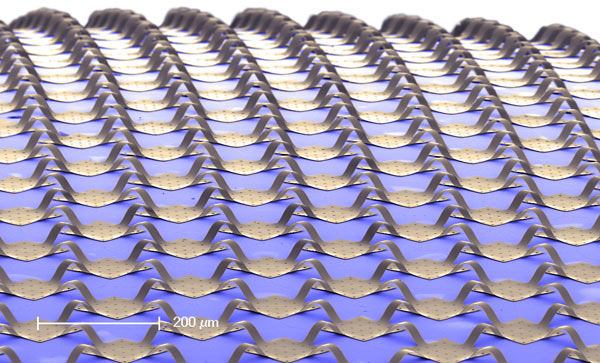 |
| Stretchable mesh: The square silicon photodetectors, connected by thin ribbons of metal and polymer, are mounted on a hemisphere-shaped rubber surface. The entire device is able to conform to any curvilinear shape due to the flexibility of the ribbons that connect the silicon islands. Credit: Beckman Institute, University of Illinois |
"This technology heralds the advent of a new class of imaging devices with wide-angle fields of view, low distortion, and compact size," says Takao Someya, a professor of engineering at the University of Tokyo, who was not involved in the research. "I believe this work is a real breakthrough in the field of stretchable electronics."
Rogers isn't the first to use the concept of a stretchable electronic mesh, but this work distinguishes itself in that it is not constrained to stretching in limited directions, like other stretchable electronic meshes. And importantly, his is the first stretchable mesh to be implemented in an artificial eye camera.
The camera's resolution is 256 pixels. At the moment, it's difficult to improve resolution due to the limitations of the fabrication facilities at the University of Illinois, says Rogers. "At some level, it's a little frustrating because you have this neat electronic eye and everything's pixelated," he says. But his team has sidestepped the problem by taking another cue from biology. The human eye dithers from side to side, constantly capturing snippets of images; the brain pieces the snippets together to form a complete picture. In the same way, Rogers's team runs a computer program that makes the images crisper by interpolating multiple images taken from different angles.
The most immediate application for these eyeball cameras, says Rogers, is most likely with the military. The simple, compact design could be used in imaging technology in the field, he suggests. And while the concept of an electronic eye conjures up images of eye implants, Rogers says that at this time he is not collaborating with other researchers to make these devices biocompatible. However, he's not ruling out the possibility in the future.
Related Links:
fabric | rblg
This blog is the survey website of fabric | ch - studio for architecture, interaction and research.
We curate and reblog articles, researches, writings, exhibitions and projects that we notice and find interesting during our everyday practice and readings.
Most articles concern the intertwined fields of architecture, territory, art, interaction design, thinking and science. From time to time, we also publish documentation about our own work and research, immersed among these related resources and inspirations.
This website is used by fabric | ch as archive, references and resources. It is shared with all those interested in the same topics as we are, in the hope that they will also find valuable references and content in it.
Quicksearch
Categories
Calendar
|
|
July '25 | |||||
| Mon | Tue | Wed | Thu | Fri | Sat | Sun |
| 1 | 2 | 3 | 4 | 5 | 6 | |
| 7 | 8 | 9 | 10 | 11 | 12 | 13 |
| 14 | 15 | 16 | 17 | 18 | 19 | 20 |
| 21 | 22 | 23 | 24 | 25 | 26 | 27 |
| 28 | 29 | 30 | 31 | |||
